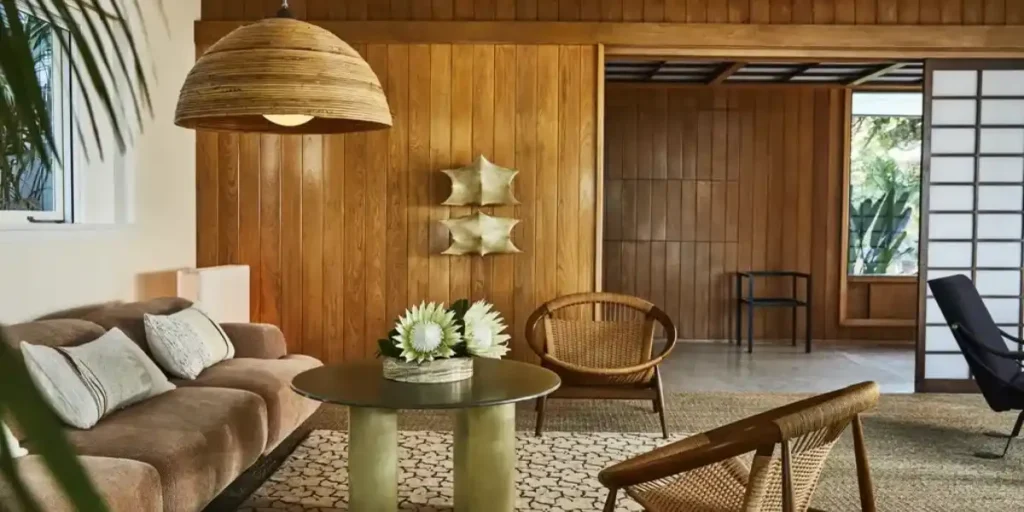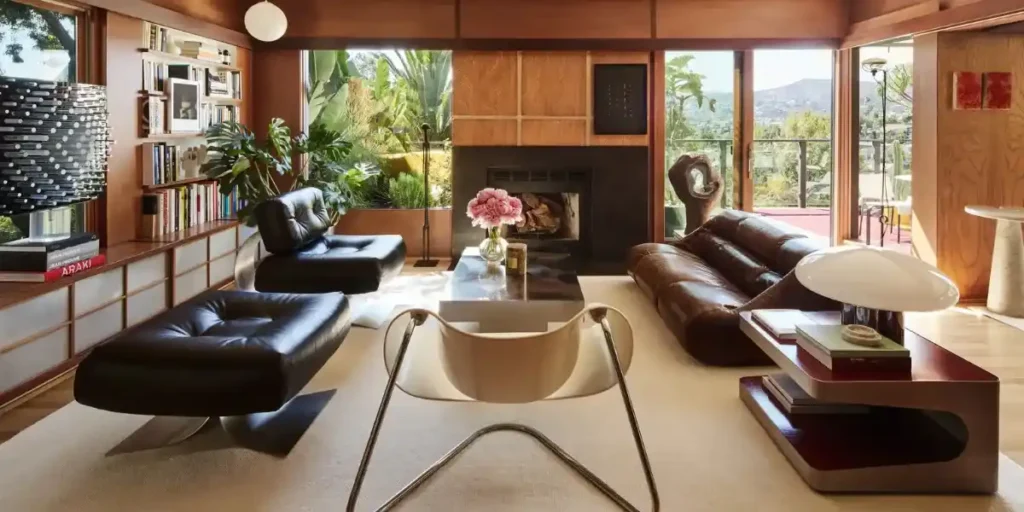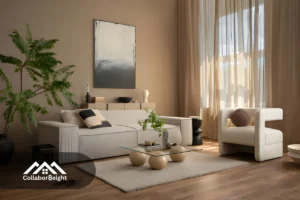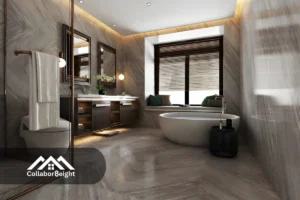When you picture a cozy yet stylish home, chances are you’re imagining elements straight out of the 1950s mid century modern house interior. This design era continues to influence today’s homes because it feels both classic and fresh. From mid century modern interiors with their clean lines to the warm comfort of a retro-inspired family home, the charm never fades.
One of the biggest reasons this style endures is its balance between beauty and function. Think about an open-plan layout that makes rooms feel bigger, or statement lamps / sputnik lighting that add character without overwhelming the space. Furniture is another highlight: tapered legs furniture instantly gives any room a sleek, modern vibe, while natural wood + contrasting materials create that warm yet dynamic feel.
Personality and Playfulness in Design
The 1950s were all about embracing creativity. Designers weren’t afraid to use bold pops of colour, and homeowners loved experimenting with geometric and atomic patterns. Even today, many people are drawn to the playful side of space-age inspired designs because they bring joy and nostalgia into everyday living.
Iconic Furniture That Defined the Era
Of course, no discussion of this style would be complete without mentioning signature furniture pieces like the Eames lounge chair, Noguchi coffee table, or Tulip dining table. These iconic mid century furniture examples remain highly sought after, proving that good design really does stand the test of time.
Whether you’re looking for 1950s living room design ideas or trying to figure out how to decorate a 1950s mid century modern home, the magic lies in mixing comfort with style. By embracing this look, you don’t just get a house that looks good—you create a home that feels timeless.
Key Characteristics of 1950s mid century modern house interior
One of the most recognizable traits of 1950s mid century modern house interior is the open-plan layout. In the 1950s, families wanted homes that felt airy and connected. Walls were minimized to create open concept living spaces mid century modern style, where the kitchen, dining, and living room flowed together. This setup encouraged togetherness while making smaller homes feel more spacious.
Another important design idea was the indoor-outdoor connection. Builders often used big glass windows and sliding doors so that the living area opened into the garden. This indoor-outdoor flow in mid century homes created harmony with nature and made homes feel brighter and more welcoming.
Furniture with a Purpose
The furniture in this era was designed to be practical yet stylish. You’ll often notice tapered legs furniture that feels light and elegant compared to bulky traditional pieces. Designers also favored natural wood + contrasting materials like metal or glass, which gave rooms a sophisticated yet approachable look.
And of course, the signature furniture pieces of the time are still icons today. The Eames lounge chair, the Noguchi coffee table, and the Tulip table are just a few iconic mid century furniture examples that continue to inspire. These items are considered affordable ways to achieve mid century modern look when paired with simpler décor.
Playful Colors and Patterns
Color played a huge role in making these interiors stand out. Homeowners embraced bold pops of colour in the living room and 1950s pastel kitchen inspiration (pink, mint, blue, yellow) in cooking spaces. This balance of soft pastels with vibrant tones kept homes cheerful and full of personality.
Patterns also had their moment. Geometric patterns and textures for mid century decor were seen on wallpaper, rugs, and upholstery. The era also gave us 1950s atomic age interior design elements, inspired by the excitement of science and space exploration. These space-age inspired designs—like starbursts, orbits, and atom motifs—added a futuristic yet fun touch to everyday spaces.
Timeless Appeal Today
If you’re exploring how to decorate a 1950s mid century modern house interior, the key is to embrace these details without going overboard. Use mid century modern decor in moderation, mix in statement lamps / sputnik lighting, and select best colors for 1950s mid century modern house interior that reflect both history and your personal taste.
Even decades later, the difference between mid century modern and modern interiors is clear. Modern design can sometimes feel cold or minimal, while mid century modern blends style with warmth, ensuring your space feels both inviting and chic.
Designing Your Own Retro-Inspired Family Home
If you want to create a retro-inspired family home, the first thing to think about is the layout. A true 1950s living room design focused on openness, so aim for an open-plan layout where rooms flow into each other. Knocking down unnecessary walls or using large archways can help you achieve an open concept living spaces mid century modern style.
Don’t forget the indoor-outdoor connection. Add large windows, glass doors, or even a sunroom to bring natural light and greenery into your daily living space. This sense of openness is what makes mid century homes feel fresh, even today.
Choose Statement Furniture
Furniture is the soul of mid century modern decor. Look for tapered legs furniture, clean lines, and pieces made from natural wood + contrasting materials like metal, leather, or glass. These choices instantly set the right tone.
Adding a few signature furniture pieces (Eames, Noguchi, Tulip table, etc.) can transform your living area from ordinary to timeless. Even if originals are expensive, reproductions are widely available and offer affordable ways to achieve mid century modern look without breaking the bank.
Add Character with Lighting and Colors
Lighting is where you can have fun. Go bold with statement lamps / sputnik lighting to capture the 1950s futuristic vibe. These designs not only light up your space but also serve as art pieces that spark conversation.
When it comes to color, think balance. Use bold pops of colour in the living room through cushions, rugs, or art, and explore 1950s pastel kitchen inspiration (pink, mint, blue, yellow) for a softer, nostalgic touch. Choosing the best colors for mid century modern interiors is about mixing vibrant energy with soothing tones.
Patterns and Details That Matter
For authenticity, embrace geometric and atomic patterns. These can appear in wallpapers, curtains, or upholstery to highlight the playful yet sophisticated look. 1950s atomic age interior design elements and space-age inspired designs (like starbursts or orbital shapes) instantly transport your home back to the Atomic Age.
The Perfect Balance
The beauty of decorating lies in moderation. If you’re learning how to decorate a 1950s mid century modern home, the key is to blend vintage touches with modern comfort. A few iconic mid century furniture examples, clever lighting, and nostalgic patterns can help you design a stylish, warm, and truly timeless home.

Color Palettes and Materials That Define Mid Century Style
One of the first things you’ll notice about mid century modern interiors is the balance between calm neutrals and playful accents. Designers loved using muted base tones, then adding bold pops of colour to bring life into the room. Think of a soft cream wall paired with a bright orange chair or a teal sofa. This contrast creates energy without feeling overwhelming.
If you’re unsure where to start, look at 1950s pastel kitchen inspiration (pink, mint, blue, yellow). These colors bring a lighthearted, nostalgic feel to your space. On the other hand, in living rooms, the best colors for mid century modern interiors include earthy greens, mustard yellow, burnt orange, and even deep navy. The idea is to strike the perfect harmony between subtle and standout.
Materials That Tell a Story
Materials were a huge part of 1950s atomic age interior design elements. Instead of sticking to just one texture, homeowners combined natural wood + contrasting materials like glass, metal, and stone. For example, a walnut dining table paired with sleek metal legs feels both timeless and modern.
Another hallmark of the style is laminates and formica countertops, especially in kitchens. These surfaces were practical and added to the space-age inspired designs that people loved back then.
Furniture That Defines the Era
If you want to really capture the look, focus on tapered legs furniture made from warm wood tones. Clean lines and smooth surfaces make your home feel uncluttered, while the right signature furniture pieces (Eames, Noguchi, Tulip table, etc.) anchor the design. These pieces aren’t just furniture—they’re conversation starters and works of art.
Adding a few iconic mid century furniture examples to your collection is the easiest way to get authenticity. Even one well-chosen chair or table can completely transform a room.
Patterns, Textures, and Finishing Touches
Don’t underestimate the impact of detail. Geometric patterns and textures for mid century decor are a must. Whether it’s a rug with bold triangles, curtains with atomic starbursts, or even small ceramics with angular designs, patterns add personality and make your space come alive.
The finishing touches can include statement lamps / sputnik lighting, patterned throw pillows, and fun artwork. These details tie your room together while keeping it playful and true to its roots.
Why It Works Today
What makes this style timeless is its adaptability. You can recreate open concept living spaces mid century modern style with just the right palette and materials, while still enjoying modern comfort. By blending colors, textures, and affordable ways to achieve mid century modern look, you end up with a space that feels inviting, stylish, and uniquely yours.
Furniture and Signature Pieces That Anchor the Look
When people think about mid century modern interiors, the first images that come to mind are the signature furniture pieces (Eames, Noguchi, Tulip table, etc.). These aren’t just functional items—they’re design icons that defined an entire era. In fact, even one carefully chosen piece can give your home that unmistakable retro-inspired family home vibe.
The Beauty of Tapered Legs
Perhaps the most recognizable feature of this style is tapered legs furniture. Sofas, chairs, and tables designed with slim, angled legs instantly make a room feel lighter and more spacious. The design feels minimal but stylish, and it helps highlight the clean, uncluttered look of a 1950s living room design.
Statement Furniture as Art
Think of a sculptural Noguchi coffee table, an Eames lounge chair, or a sleek Tulip dining table. These aren’t just furniture—they’re statement pieces that double as art. Adding even one of these iconic mid century furniture examples instantly elevates your room and brings authenticity.
If you’re decorating on a budget, don’t worry. Many brands today offer replicas or affordable ways to achieve a mid century modern look. The key is to focus on shape and material—wood, metal, and simple forms will always give the right feel.
Comfort Meets Style
What makes mid century modern decor so loved today is the balance between comfort and beauty. Sofas and chairs were designed for everyday life while still looking stylish. An open-plan layout paired with these timeless designs creates a warm and inviting space where family and friends can gather.
Finishing the Look
To round things off, don’t forget lighting and accessories. A bold statement lamp or sputnik lighting fixture instantly creates a dramatic focal point. Combine this with geometric and atomic patterns on rugs or cushions, and your space will echo the charm of 1950s atomic age interior design elements while still feeling fresh.
Lighting, Patterns, and Textures That Complete the Look
No mid century modern interiors space is complete without the right lighting. Statement lamps / sputnik lighting became iconic in the 1950s, and for good reason—they instantly draw attention while giving rooms a futuristic vibe. Think starburst chandeliers, cone-shaped pendants, or even sculptural floor lamps. These fixtures not only illuminate your space but also serve as conversation pieces.
Patterns That Pop
Patterns were essential for adding personality to retro-inspired family homes. Geometric and atomic patterns were everywhere—from rugs and upholstery to wallpaper and art. These bold, playful designs gave rooms energy and a sense of fun, while still feeling sophisticated.
Textures for Depth
Mixing natural wood + contrasting materials added depth to rooms. Combining smooth woods with metal accents, glass tabletops, or textured fabrics helped define spaces in an open-plan layout without making them feel cluttered. Textured textiles like wool rugs, patterned curtains, or cushioned chairs helped balance clean lines with comfort.
Creating the Atomic Age Feel
If you want authenticity, sprinkle in some 1950s atomic age interior design elements. Starbursts, orbit motifs, and space-age inspired designs on small accessories—like clocks, vases, or cushions—immediately transport a room back to the playful optimism of the era. These details work best when paired with bold pops of colour, giving your interiors vibrancy without overwhelming the eye.
Harmonizing All Elements
The key to perfect mid century modern decor is harmony. Combine your signature furniture pieces (Eames, Noguchi, Tulip table, etc.), open concept living spaces mid century modern style, and lighting with patterns and textures to create a cohesive look. Even a few well-chosen pieces, thoughtful color choices, and attention to geometric patterns and textures for mid century decor can transform your home into a timeless, inviting space.
By understanding the role of lighting, patterns, and textures, you can turn how to decorate a 1950s mid century modern home from a concept into reality—blending vintage charm with modern comfort.
Kitchens, Dining, and Pastel Inspiration
In a retro-inspired family home, the kitchen was the heart of daily life—and the 1950s pastel kitchen inspiration (pink, mint, blue, yellow) made it cheerful and inviting. These soft pastel shades paired with natural wood + contrasting materials created a cozy yet stylish space. Cabinets, countertops, and even appliances could carry these playful hues while maintaining a clean, uncluttered look.
Open Concept Dining
Dining areas often embraced an open-plan layout, blending seamlessly with the kitchen and living spaces. This created open concept living spaces mid century modern style, ideal for family gatherings or entertaining friends. Using a Tulip table or tapered legs furniture for chairs and sideboards maintained the era’s signature sleek aesthetic.
Lighting That Inspires
In the kitchen and dining areas, statement lamps / sputnik lighting added both flair and function. A well-placed pendant over the dining table or a sculptural floor lamp nearby could serve as a focal point while brightening the space.
Patterns and Accessories
Don’t shy away from geometric and atomic patterns in the kitchen or dining space. Think patterned tile backsplashes, rugs with angular motifs, or curtains with subtle starbursts. Accessories with space-age inspired designs, like vases or bowls, helped reinforce the 1950s charm.
Balancing Style and Function
The beauty of mid century modern interiors is that style never sacrifices function. Even while using vibrant colors and playful patterns, practical layouts and signature furniture pieces (Eames, Noguchi, Tulip table, etc.) ensured the space remained usable and comfortable. For a cohesive look, pair pastel tones with bold pops of colour on accents like chairs, cushions, or dishware.
Whether you’re aiming for how to decorate a 1950s mid century modern home or seeking 1950s living room design ideas for an adjoining space, incorporating these pastel colors and classic furniture pieces will make your kitchen and dining areas feel authentic, welcoming, and timeless.
Living Room and Relaxation Areas
The living room is the centerpiece of any retro-inspired family home. In mid century modern interiors, the focus is on comfort, style, and functionality. An open-plan layout allows for seamless flow between the kitchen, dining, and living areas, creating open concept living spaces mid century modern style that feel spacious and welcoming.
Signature Furniture Choices
Investing in signature furniture pieces (Eames, Noguchi, Tulip table, etc.) instantly elevates your living room. A classic Eames lounge chair paired with a sleek tapered legs furniture sofa adds elegance and timeless appeal. These iconic mid century furniture examples aren’t just beautiful—they’re functional, designed for lounging, reading, or spending time with family.
Lighting for Mood and Style
Lighting plays a huge role in setting the atmosphere. Statement lamps / sputnik lighting bring drama and sophistication, while also serving as conversation pieces. Consider placing one near a reading corner or above a coffee table to highlight your décor and geometric and atomic patterns.
Patterns, Textures, and Color
The living room is the perfect place for bold pops of colour and space-age inspired designs. Cushions, rugs, and throws featuring geometric patterns and textures for mid century decor help tie the room together. Combine these with natural wood + contrasting materials for tables and cabinets to create warmth and visual interest.
Comfort Meets Style
One of the standout features of mid century modern decor is balancing style with comfort. Furniture should invite relaxation while maintaining aesthetic appeal. 1950s living room design ideas often include a mix of low-profile sofas, wood tables, and accent chairs that encourage conversation and cozy evenings.
Bringing it Together
To achieve how to decorate a 1950s mid century modern home, focus on integrating open-plan layouts, signature furniture, playful patterns, and thoughtful lighting. By combining these elements, your living room becomes a hub that is timeless, functional, and full of character, perfectly embodying the difference between mid century modern and modern interiors.
Bedroom and Private Spaces
Bedrooms in mid century modern interiors were designed to be peaceful yet stylish retreats. Clean lines, minimal clutter, and a thoughtful balance of natural wood + contrasting materials created a relaxing environment. Using a tapered legs furniture bed frame or nightstand instantly adds the classic 1950s charm.
Signature Furniture for Comfort
Even in private spaces, signature furniture pieces (Eames, Noguchi, Tulip table, etc.) make a statement. A cozy reading chair like an Eames lounge chair in the corner or a small Noguchi side table adds both functionality and aesthetic appeal. These iconic mid century furniture examples bring personality without overwhelming the room.
Colors and Patterns
Bedrooms are ideal for experimenting with bold pops of colour in small doses—like cushions, bedspreads, or accent walls. Soft tones from 1950s pastel kitchen inspiration (pink, mint, blue, yellow) can also be used to maintain a calm, soothing environment. For added visual interest, geometric patterns and textures for mid century decor on rugs or wall art tie the theme together, while 1950s atomic age interior design elements keep the space playful yet elegant.
Lighting for Relaxation
A key aspect of mid century modern decor is lighting. Statement lamps / sputnik lighting in bedrooms not only provide adequate illumination but also add a touch of drama. Bedside lamps or a hanging fixture can highlight furniture pieces and bring a cozy glow to the room.
Creating a Personal Retreat
To really capture how to decorate a 1950s mid century modern home, private spaces should balance style and comfort. Use space-age inspired designs sparingly—think a small accent or decorative piece—to maintain serenity while showcasing personality. This careful balance illustrates the difference between mid century modern and modern interiors, keeping the home timeless and welcoming.
Harmonizing the Bedroom
By combining mid century modern interiors, open-plan layout principles in connected areas, signature furniture, playful patterns, and thoughtful colors, bedrooms become tranquil, stylish retreats that complement the rest of the home.
Bringing It All Together – Tips for a Cohesive 1950s Home
When decorating a retro-inspired family home, having a clear plan helps tie everything together. Begin by mapping out an open-plan layout for your main living areas. This allows you to maintain open concept living spaces mid century modern style, where the kitchen, dining, and living room flow seamlessly into one another.
Mix and Match Signature Pieces
Integrating signature furniture pieces (Eames, Noguchi, Tulip table, etc.) across rooms gives your home a sense of unity. Pair tapered legs furniture with natural wood + contrasting materials to balance functionality and aesthetics. Even just a few iconic mid century furniture examples can set the tone throughout your home.
Color Consistency
Use a consistent palette to create cohesion. Combine bold pops of colour in living areas with soft 1950s pastel kitchen inspiration (pink, mint, blue, yellow) in cooking or bedroom spaces. Selecting the best colors for mid century modern interiors ensures each room feels connected while maintaining its own personality.
Patterns and Textures
Incorporate geometric patterns and textures for mid century decor subtly across different rooms. Rugs, cushions, wallpaper, and small decorative items featuring 1950s atomic age interior design elements or space-age inspired designs will help create continuity without overwhelming the eye.
Lighting for Harmony
Lighting ties the entire home together. Use statement lamps / sputnik lighting strategically in every space—from living rooms to bedrooms—to highlight furniture, create focal points, and emphasize the indoor-outdoor connection where possible.
Balance Style and Comfort
Finally, the key to a cohesive mid century modern decor is balance. Mix playful designs with functional layouts, and don’t overfill spaces. This approach ensures your home feels inviting, timeless, and true to its era. Following these principles shows how to decorate a 1950s mid century modern home that reflects personality while maintaining elegance.
Frequently Asked Questions (FAQs)
What are the key features of 1950s mid century modern house interiors?
Mid century modern interiors from the 1950s are defined by clean lines, tapered legs furniture, open-plan layout, and the clever use of natural wood + contrasting materials. Bold colors, geometric and atomic patterns, and space-age inspired designs also make these homes stand out.
How can I create a retro-inspired family home today?
To achieve a retro-inspired family home, start with an open concept living spaces mid century modern style. Add signature furniture pieces (Eames, Noguchi, Tulip table, etc.), statement lamps / sputnik lighting, and a mix of bold pops of colour with 1950s pastel kitchen inspiration (pink, mint, blue, yellow). Balance style and comfort for a cohesive look.
What are some affordable ways to achieve mid century modern look?
You don’t need to spend a fortune! Look for affordable ways to achieve mid century modern look by choosing replicas of iconic mid century furniture examples, mixing in mid century modern decor accents, and using geometric patterns and textures for mid century decor in small doses like cushions, rugs, or artwork.
How do I decorate a 1950s mid century modern home?
Focus on how to decorate a 1950s mid century modern home by combining tapered legs furniture, bold pops of colour, natural wood + contrasting materials, and lighting like statement lamps / sputnik lighting. Maintain an indoor-outdoor connection where possible, and use patterns, textures, and signature furniture to bring the era to life.
What is the difference between mid century modern and modern interiors?
The difference between mid century modern and modern interiors is mainly in warmth and character. Mid century modern interiors incorporate natural wood + contrasting materials, playful geometric and atomic patterns, and iconic furniture pieces that make spaces feel inviting. Modern interiors often lean toward minimalism and may feel colder or more sterile.
Which colors are best for mid century modern interiors?
The best colors for mid century modern interiors include soft pastels for kitchens (1950s pastel kitchen inspiration) and bold pops of colour in living areas. Earthy tones like mustard yellow, burnt orange, olive green, and warm neutrals work beautifully with natural wood finishes.
Can mid century modern interiors work in small homes?
Absolutely! Even smaller homes can use open concept living spaces mid century modern style and tapered legs furniture to create a sense of openness. Incorporate signature furniture pieces and space-age inspired designs strategically to keep the space stylish without overcrowding it.





